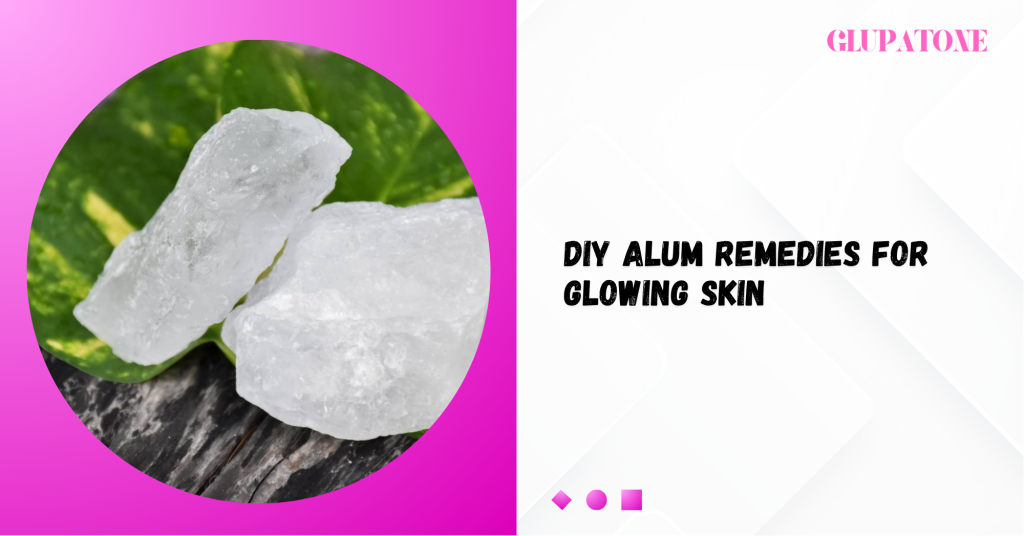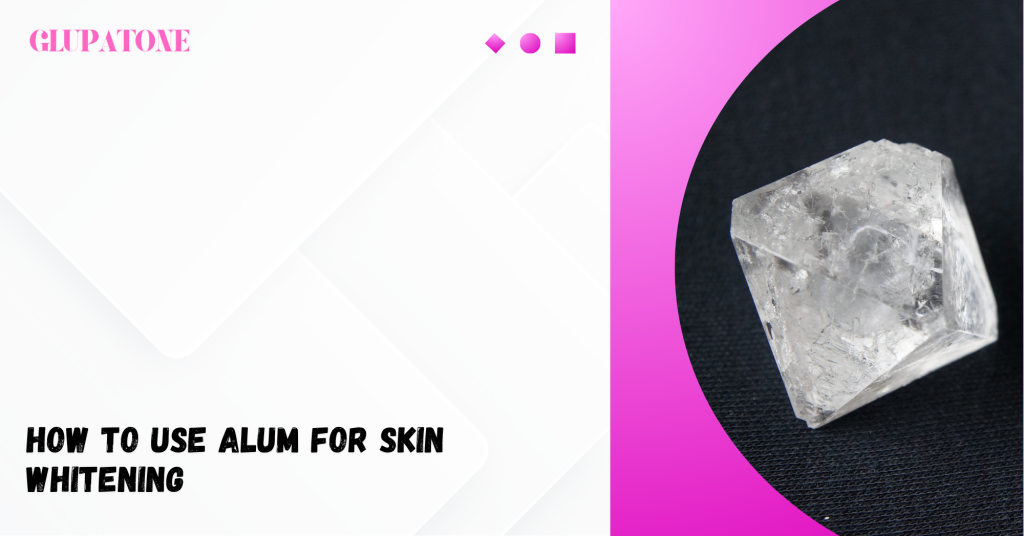Introduction to Alum
Alum is a naturally occurring salt compound, often used in crystal or powder form. It’s known for its antibacterial, astringent, and skin-tightening properties. In skincare, it’s most commonly used for treating acne, tightening pores, and yes—helping brighten the skin. You can use Alum for Skin Whitening and other purposes.
It’s easy to find, affordable, and has been used in beauty routines for generations, especially in South Asia and the Middle East.
Types of Alum Used in Skincare
The most popular type for skincare is Potassium Alum, usually sold as a solid block or powder. This is the same kind often used as a natural deodorant or aftershave. Another type, Ammonium Alum, is less commonly used for skin and more for industrial purposes, so it’s best to stick with Potassium Alum for face and body care.
Why Use Alum for Skin Whitening?
Alum helps brighten skin by tightening the pores, reducing oiliness, and giving your skin a smoother, more refined look. With regular use, it can also make dull or tired skin look fresher. It’s not a bleach, but it can even out your skin tone and lighten dark areas over time.
Another benefit? It’s super gentle when used correctly—so you don’t have to worry about harsh chemicals.
How Alum Works on Pigmentation and Dark Spots
Alum has natural exfoliating and antibacterial properties. It gently removes dead skin cells and helps fade dark spots and minor pigmentation. When combined with ingredients like rose water or lemon juice, it can target areas with hyperpigmentation and gradually brighten the skin’s appearance.
It’s not an overnight miracle—but it’s a natural, gradual, and safe option if you stay consistent.
Reveal a Brighter, More Radiant You—Experience Glupatone Today!
Glow Naturally! Achieve Even Skin Tone with the Power of Glupatone
Is Alum Safe for Skin?
Skin Types That Can Use Alum
Alum is generally safe for:
- Normal to oily skin
- Acne-prone skin
- Combination skin
However, those with very dry or sensitive skin should be more cautious, as it may cause dryness or a tight feeling if overused.
Common Side Effects and Safety Tips
If used too often or left on for too long, alum can lead to:
- Dryness
- Redness or mild irritation
- Tight or flaky skin
To stay safe:
- Always patch test first
- Use alum in small amounts
- Moisturize after application
- Don’t use it with harsh scrubs or strong actives on the same day
How to Use Alum for Skin Whitening
Using alum is super simple! Just follow these easy steps:
- Cleanse your face with a gentle face wash and pat dry.
- Wet the alum block or powder slightly with water or rose water.
- Rub it gently on the skin in circular motions—avoid the eyes and lips.
- Let it sit for a few minutes, then rinse with cool water.
- Finish with a moisturizer to keep your skin soft and hydrated.
Using Alum in Powder vs. Block Form
- Block Form: Perfect for quick, no-mess use. Just wet and rub it directly on the skin.
- Powder Form: Great for making DIY masks or mixing with natural ingredients like rose water or lemon.
Both forms work well—it just depends on how you prefer to apply it.
How Long to Leave It on the Skin
Keep alum on your face for no more than 10 minutes. Leaving it on too long may dry out your skin, especially if you already have dry or sensitive skin. Always rinse thoroughly and moisturize right after.

DIY Alum Remedies for Glowing Skin
Alum and Rose Water Paste
This combo helps tone and brighten the skin.
- Mix 1 teaspoon of alum powder with 2 teaspoons of rose water.
- Apply as a thin layer and leave on for 5–7 minutes.
- Rinse with cool water and moisturize.
Alum and Glupatone
This is great for fading dark spots.
- Mix alum powder with a few drops of Glupatone.
- Apply only on pigmented areas.
- Leave for 3–5 minutes, then rinse.
- Use only at night and apply sunscreen the next day.
Alum with Multani Mitti for Oily Skin
Perfect for oily or acne-prone skin.
- Mix 1 tsp of multani mitti, ½ tsp alum powder, and some rose water.
- Apply as a face pack.
- Let it dry for 10 minutes, then rinse off gently.
Tips for Mixing with Other Natural Ingredients
- Always use clean tools and bowls.
- Stick to natural liquids like rose water or aloe vera gel.
- Don’t mix with acids or scrubs to avoid irritation.
Support Healthy, Luminous Skin—Try Glupatone’s Gentle Yet Effective Formula!
Confident Skin Starts Here—Discover the Glow Within with Glupatone.
When and How Often to Use Alum on Skin
- For oily or acne-prone skin, you can use alum every other day.
- For dry or sensitive skin, once or twice a week is enough.
- Don’t overdo it—too much alum can cause dryness or tightness.
Best Time of Day for Application
Nighttime is best! It allows your skin to absorb the benefits without sun exposure. If you use it during the day, always apply a broad-spectrum sunscreen afterward.
Things to Avoid When Using Alum
Skincare Ingredients That Don’t Mix Well with Alum
While alum is natural, it still doesn’t play nice with every product. Avoid using it alongside:
- Strong chemical exfoliants (like AHA/BHA)
- Retinols or retinoids
- Harsh scrubs or peeling solutions
Using these together can cause redness, irritation, or even breakouts. Keep it simple and gentle when alum is part of your routine.
Why You Should Avoid Overuse
Using alum too often can lead to dryness or tight, flaky skin. Even if you love the results, don’t go overboard. It’s best to give your skin time to breathe and repair. More doesn’t mean better when it comes to natural ingredients.
Results and What to Expect
Timeline for Visible Skin Whitening
If you’re consistent, you may start seeing subtle changes in 2 to 3 weeks. Your skin may appear:
- Brighter
- Smoother
- More even in tone
However, remember that alum is not a bleaching agent—results are gradual and natural.
Signs That It’s Working
You’ll know it’s working when your skin starts feeling:
- Softer and firmer
- Less oily or greasy
- Fresh and glowy after each use
If you feel any stinging or burning, stop and recheck how you’re applying it.
Conclusion: Can Alum Really Brighten Skin?
Yes—but the key is patience and consistency. Alum isn’t magic, but when used correctly, it helps tighten pores, control oil, and fade dull patches. Over time, this leads to brighter, healthier-looking skin.
For best results, pair alum with a good moisturizer and sun protection, and don’t forget to keep your routine gentle and balanced. Nature works best when you let it do its thing—slow and steady!
Frequently Asked Questions (FAQs)
Can I use alum on my face daily?
If you have oily or normal skin, yes—up to 3–4 times a week. For dry or sensitive skin, stick to once or twice weekly.
Does alum permanently whiten skin?
No, alum improves brightness and reduces dullness, but it doesn’t offer permanent whitening. Results fade if you stop using it.
Can alum remove dark spots?
It may help fade minor pigmentation or acne scars over time, especially when mixed with lemon juice or rose water.
Is alum good for oily or acne-prone skin?
Yes! Its natural astringent properties help control oil and tighten pores, making it ideal for acne-prone skin.
Can men use alum for skin whitening?
Absolutely! Skincare has no gender. Men can use alum in the same way as women for brightening and toning.
What should I apply after using alum?
Always apply a gentle moisturizer to hydrate your skin and lock in softness. Use sunscreen during the day.
Are there any natural alternatives to alum?
Yes, you can try turmeric, sandalwood, or rice water—all are gentle and help with brightening in their own way.
Can I use makeup after applying alum?
Yes, but allow the alum to fully absorb or rinse off before applying makeup. Always moisturize first for a smooth base.
Latest Posts:

